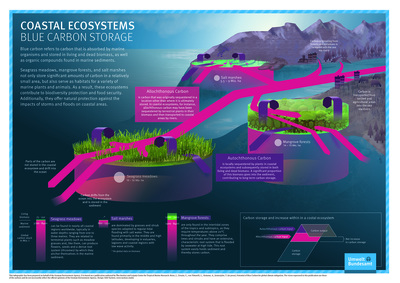Potential of Blue Carbon for global climate change mitigation.
Reise, Judith, Urrutia, Cristina, von Vittorelli, Laura, Siemons, Anne and Jennerjahn, Tim  ORCID: https://orcid.org/0000-0003-1022-5126
(2024)
Potential of Blue Carbon for global climate change mitigation.
, ed. by
Umwelbundesamt, UBA, Voß, Katja and Erxleben, Friederike.
Emissionsbilanz erneuerbarer Energieträger, 24
.
Umweltbundesamt, Berlin, 39 pp.
ORCID: https://orcid.org/0000-0003-1022-5126
(2024)
Potential of Blue Carbon for global climate change mitigation.
, ed. by
Umwelbundesamt, UBA, Voß, Katja and Erxleben, Friederike.
Emissionsbilanz erneuerbarer Energieträger, 24
.
Umweltbundesamt, Berlin, 39 pp.
|
Text
Jennerjahn 2.pdf - Published Version Available under License Creative Commons: Attribution 4.0. Download (770kB) |
||
![[img]](http://cris.leibniz-zmt.de/5458/2.hassmallThumbnailVersion/Bluecarbon%20disclaimer.jpg)
|
Image
Bluecarbon disclaimer.jpg - Published Version Available under License Creative Commons: Attribution 4.0. Download (3MB) | Preview |
|
![[img]](http://cris.leibniz-zmt.de/5458/3.hassmallThumbnailVersion/bluecarbon%20deutsch.jpg)
|
Image
bluecarbon deutsch.jpg - Published Version Available under License Creative Commons: Attribution 4.0. Download (3MB) | Preview |
Abstract
Achieving climate neutrality primarily requires reducing greenhouse gas (GHG) emissions. However, in addition it requires measures to absorb CO2 from the atmosphere and storing carbon in the long term to balance unavoidable residual emissions. A key measure available for countries to achieve this is to maintain and enlarge natural carbon sinks. In this respect, measures to protect and restore coastal ecosystems such as mangrove forests, seagrass meadows and tidal marshes are attracting growing attention as they are important natural marine carbon sinks and store a lot of carbon per unit area in their sediments. Therefore, they are often referred to as "Blue Carbon ecosystems” (BCE). Although the term “Blue Carbon” (BC) is not yet uniformly defined, it is becoming more and more prominent in international climate policy and is being discussed in the context of the (voluntary) carbon market, among other things. This study provides an overview of the use of the term BC in scientific literature and international reports in order to derive a working definition of BC and criteria for identifying BC measures (Chapter 2). In the following chapters we summarize and critically assess positive contributions and limits of the global climate mitigation potential of BCE (Chapter 3) and present a summary of the discussions and the future role of BC in international climate policy (Chapter 4). In Chapter 5, the visibility of BC emissions and removals in national GHG inventories is summarized. Based on these analyses, Chapter 6 provides conclusions and recommendations for the future use of the term BC and summarizes its potential contribution to global climate mitigation.
| Document Type: | Report (Research Report) |
|---|---|
| Programme Area: | PA3, PA5 |
| Research affiliation: | Biogeochemistry and Geology > Ecological Biogeochemistry |
| ISSN: | 1862-4359 |
| Date Deposited: | 22 Jul 2024 08:05 |
| Last Modified: | 22 Jul 2024 08:05 |
| URI: | https://cris.leibniz-zmt.de/id/eprint/5458 |
Actions (login required)
 |
View Item |





 Tools
Tools Tools
Tools

